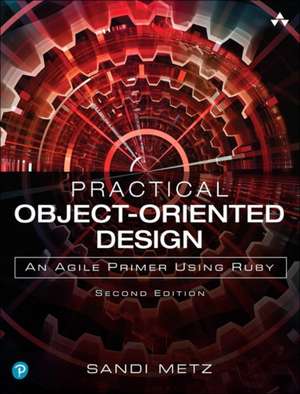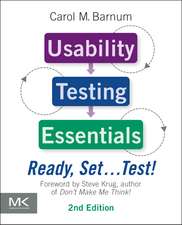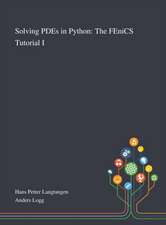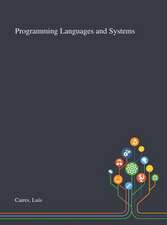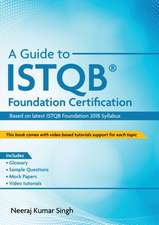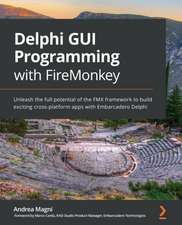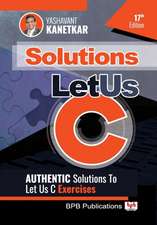Practical Object-Oriented Design
Autor Sandi Metzen Limba Engleză Paperback – 22 aug 2018
Preț: 240.27 lei
Preț vechi: 300.34 lei
-20% Nou
Puncte Express: 360
Preț estimativ în valută:
45.97€ • 48.13$ • 38.04£
45.97€ • 48.13$ • 38.04£
Carte disponibilă
Livrare economică 15-29 martie
Livrare express 04-08 martie pentru 34.28 lei
Preluare comenzi: 021 569.72.76
Specificații
ISBN-13: 9780134456478
ISBN-10: 0134456475
Pagini: 288
Dimensiuni: 177 x 231 x 20 mm
Greutate: 0.54 kg
Ediția:2nd edition
Editura: Pearson Education
ISBN-10: 0134456475
Pagini: 288
Dimensiuni: 177 x 231 x 20 mm
Greutate: 0.54 kg
Ediția:2nd edition
Editura: Pearson Education
Notă biografică
Sandi Metz is a programmer, teacher, author, and sometime consultant. In the past 30+ years she has written innumerable applications and creates practical solutions that produce working software that is easy to change. She has spoken about object-oriented design and refactoring at international Ruby conferences since 2009.
Cuprins
Introduction xv
Acknowledgments xix
About the Author xxi
Chapter 1: Object-Oriented Design 1
1.1 In Praise of Design 2
1.2 The Tools of Design 4
1.3 The Act of Design 6
1.4 A Brief Introduction to Object-Oriented Programming 10
1.5 Summary 13
Chapter 2: Designing Classes with a Single Responsibility 15
2.1 Deciding What Belongs in a Class 16
2.2 Creating Classes That Have a Single Responsibility 17
2.3 Writing Code That Embraces Change 24
2.4 Finally, the Real Wheel 33
2.5 Summary 35
Chapter 3: Managing Dependencies 37
3.1 Understanding Dependencies 38
3.2 Writing Loosely Coupled Code 41
3.3 Managing Dependency Direction 53
3.4 Summary 59
Chapter 4: Creating Flexible Interfaces 61
4.1 Understanding Interfaces 61
4.2 Defining Interfaces 63
4.3 Finding the Public Interface 65
4.4 Writing Code That Puts Its Best (Inter)Face Forward 77
4.5 The Law of Demeter 80
4.6 Summary 84
Chapter 5: Reducing Costs with Duck Typing 85
5.1 Understanding Duck Typing 85
5.2 Writing Code That Relies on Ducks 95
5.3 Conquering a Fear of Duck Typing 100
5.4 Summary 103
Chapter 6: Acquiring Behavior through Inheritance 105
6.1 Understanding Classical Inheritance 105
6.2 Recognizing Where to Use Inheritance 106
6.3 Misapplying Inheritance 114
6.4 Finding the Abstraction 116
6.5 Managing Coupling between Superclasses and Subclasses 129
6.6 Summary 139
Chapter 7: Sharing Role Behavior with Modules 141
7.1 Understanding Roles 142
7.2 Writing Inheritable Code 158
7.3 Summary 161
Chapter 8: Combining Objects with Composition 163
8.1 Composing a Bicycle of Parts 163
8.2 Composing the Parts Object 168
8.3 Manufacturing Parts 176
8.4 The Composed Bicycle 181
8.5 Deciding between Inheritance and Composition 185
8.6 Summary 191
Chapter 9: Designing Cost-Effective Tests 193
9.1 Intentional Testing 194
9.2 Testing Incoming Messages 202
9.3 Testing Private Methods 215
9.4 Testing Outgoing Messages 217
9.5 Testing Duck Types 221
9.6 Testing Inherited Code 233
9.7 Summary 244
Afterword 245
Index 247
Acknowledgments xix
About the Author xxi
Chapter 1: Object-Oriented Design 1
1.1 In Praise of Design 2
1.2 The Tools of Design 4
1.3 The Act of Design 6
1.4 A Brief Introduction to Object-Oriented Programming 10
1.5 Summary 13
Chapter 2: Designing Classes with a Single Responsibility 15
2.1 Deciding What Belongs in a Class 16
2.2 Creating Classes That Have a Single Responsibility 17
2.3 Writing Code That Embraces Change 24
2.4 Finally, the Real Wheel 33
2.5 Summary 35
Chapter 3: Managing Dependencies 37
3.1 Understanding Dependencies 38
3.2 Writing Loosely Coupled Code 41
3.3 Managing Dependency Direction 53
3.4 Summary 59
Chapter 4: Creating Flexible Interfaces 61
4.1 Understanding Interfaces 61
4.2 Defining Interfaces 63
4.3 Finding the Public Interface 65
4.4 Writing Code That Puts Its Best (Inter)Face Forward 77
4.5 The Law of Demeter 80
4.6 Summary 84
Chapter 5: Reducing Costs with Duck Typing 85
5.1 Understanding Duck Typing 85
5.2 Writing Code That Relies on Ducks 95
5.3 Conquering a Fear of Duck Typing 100
5.4 Summary 103
Chapter 6: Acquiring Behavior through Inheritance 105
6.1 Understanding Classical Inheritance 105
6.2 Recognizing Where to Use Inheritance 106
6.3 Misapplying Inheritance 114
6.4 Finding the Abstraction 116
6.5 Managing Coupling between Superclasses and Subclasses 129
6.6 Summary 139
Chapter 7: Sharing Role Behavior with Modules 141
7.1 Understanding Roles 142
7.2 Writing Inheritable Code 158
7.3 Summary 161
Chapter 8: Combining Objects with Composition 163
8.1 Composing a Bicycle of Parts 163
8.2 Composing the Parts Object 168
8.3 Manufacturing Parts 176
8.4 The Composed Bicycle 181
8.5 Deciding between Inheritance and Composition 185
8.6 Summary 191
Chapter 9: Designing Cost-Effective Tests 193
9.1 Intentional Testing 194
9.2 Testing Incoming Messages 202
9.3 Testing Private Methods 215
9.4 Testing Outgoing Messages 217
9.5 Testing Duck Types 221
9.6 Testing Inherited Code 233
9.7 Summary 244
Afterword 245
Index 247
